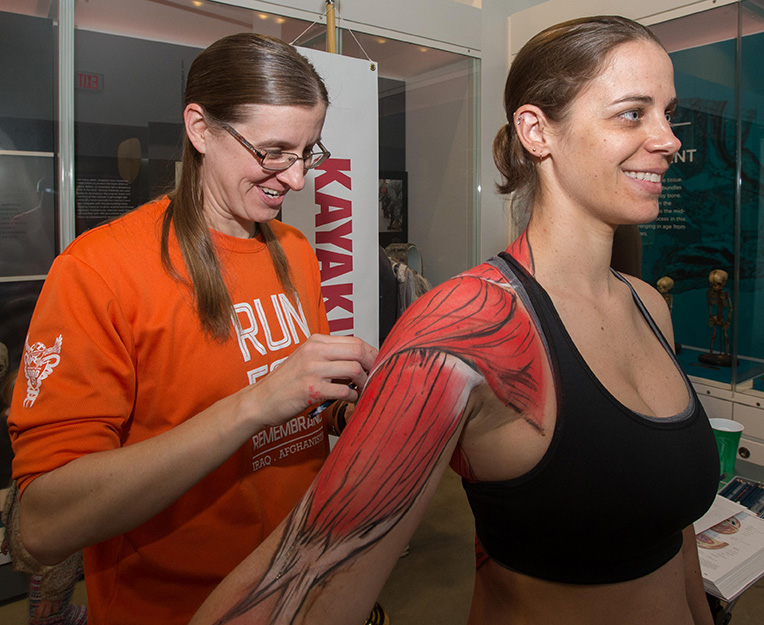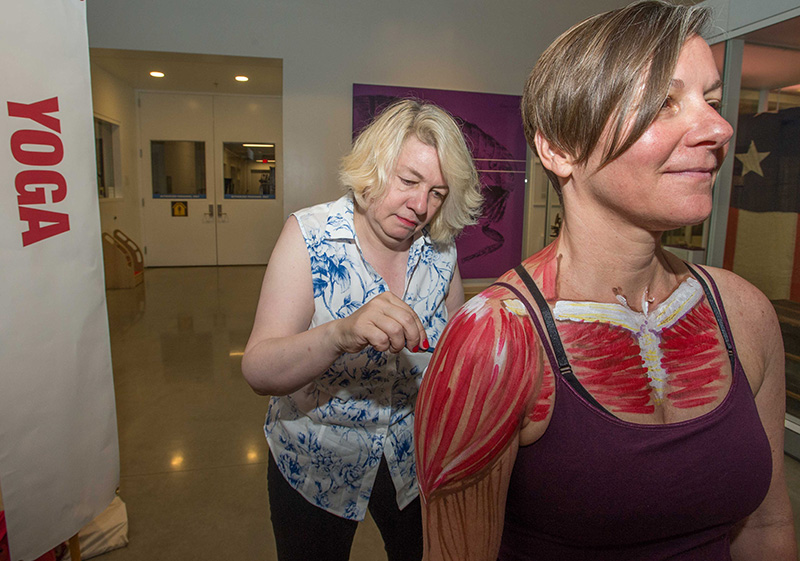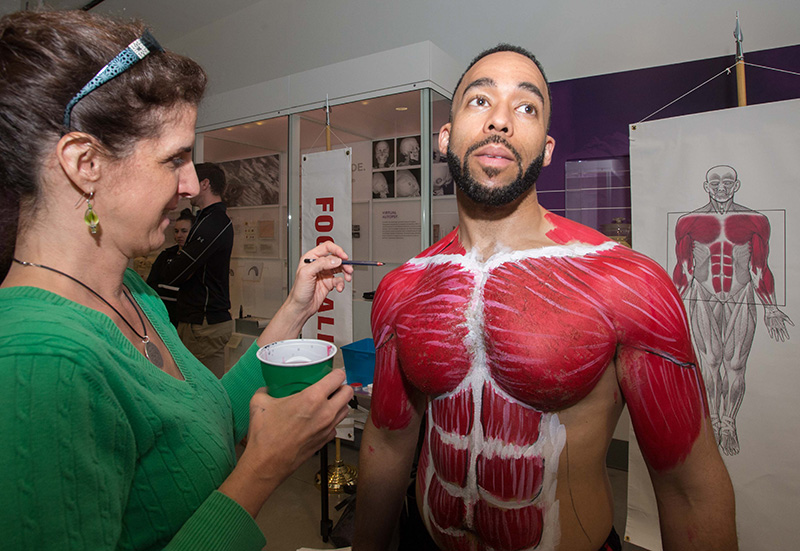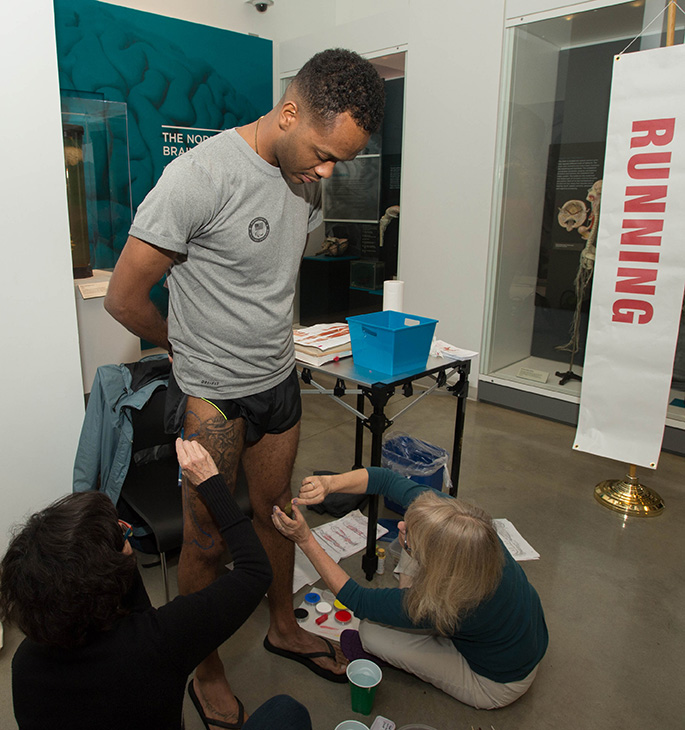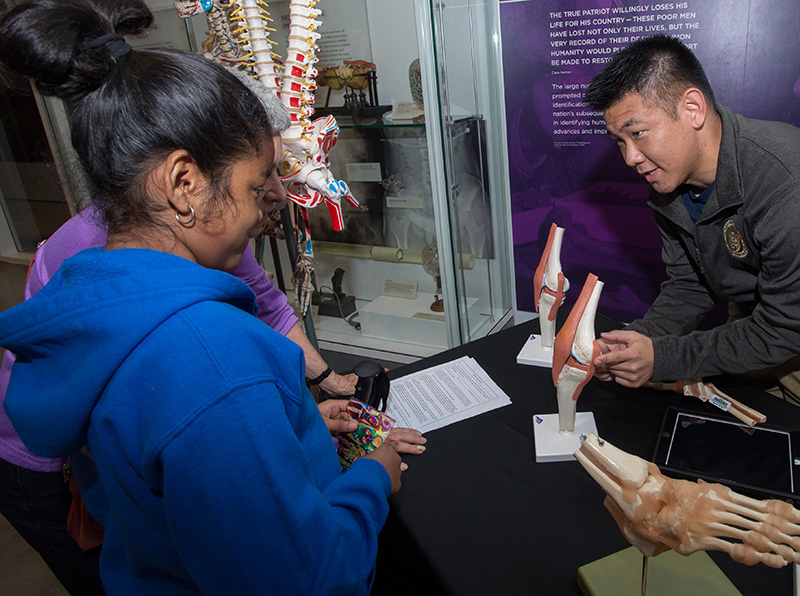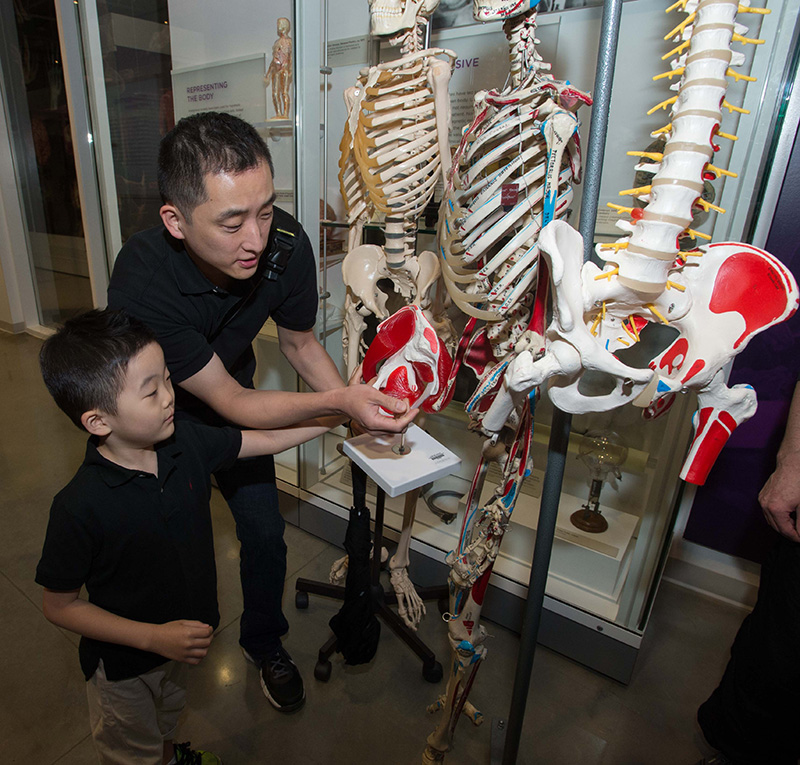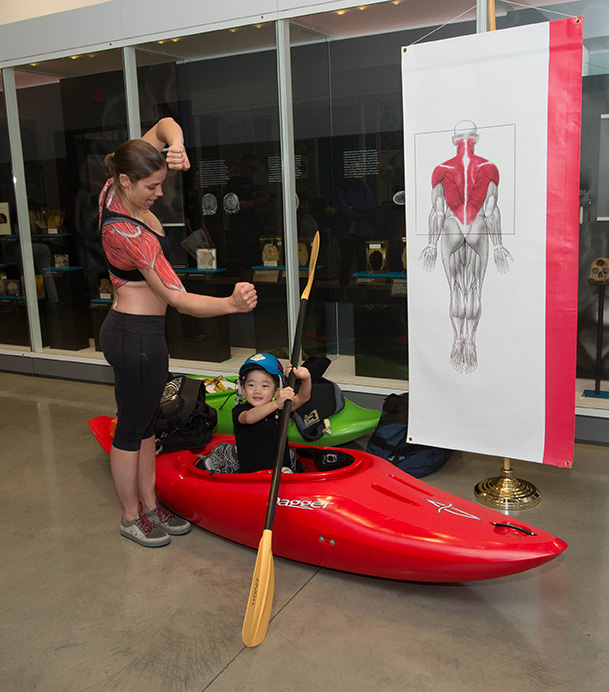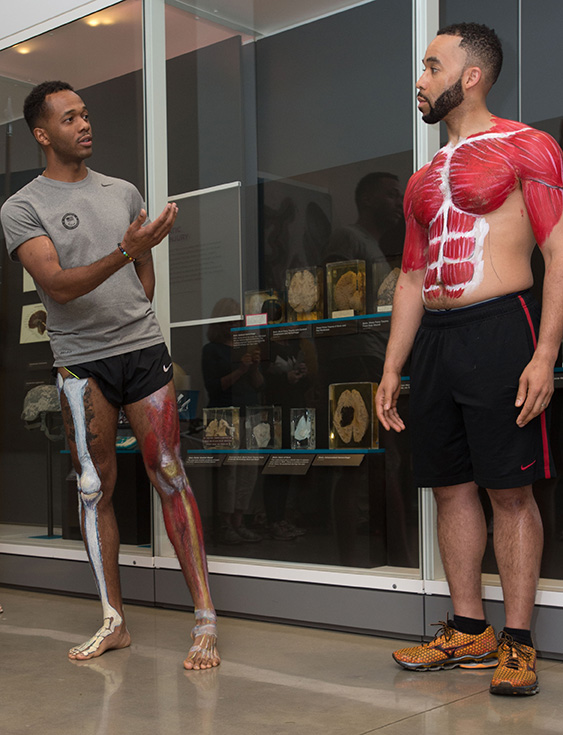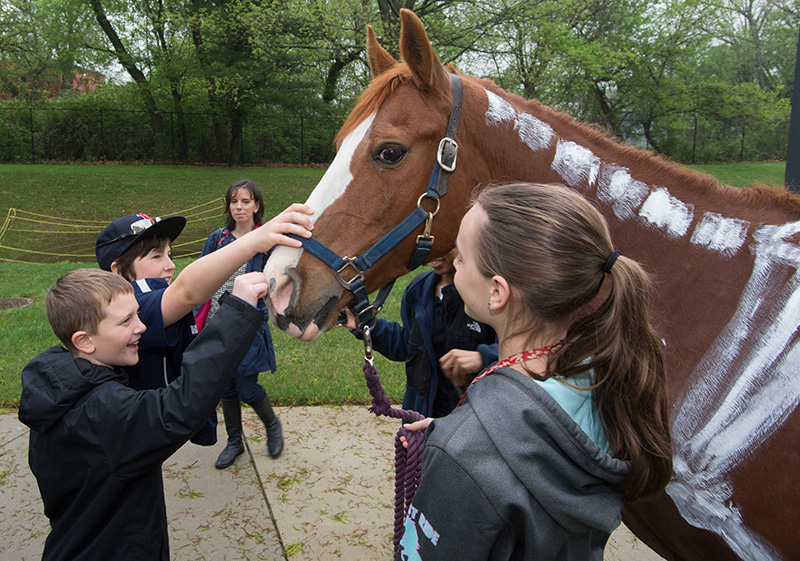Anatomy of Sports: Athletes Become Art at Military Medical Museum
By Lauren Bigge
NMHM Public Affairs Coordinator
Body painting as a vehicle for teaching anatomy caught the attention of visitors at the National Museum of Health and Medicine in Silver Spring, Md. on April 22. The museum's "Anatomy of Sports" program – now in its sixth year – pairs medical illustrators with athletes and physical therapists in an effort to educate the public about how the muscles, tendons, nerves, and bones work together in the context of sports such as running and football.
Medical illustrator Elizabeth Weissbrod painted kayaker Erica Smith's back and arms. While Smith is a novice to body paint modeling, Weissbrod has been painting during this annual event since 2012. Weissbrod said she hopes the public learns that care of muscles doesn't just apply to sports – it's about safety in practical living, too. "When they're doing yard work or something at school or at work, they know what muscles are being used. Maybe in knowing that, they'll be able to do those exercises a little safer."
Smith teaches white-water kayaking, so she is concerned about muscle protection, too. "As an instructor, it's interesting for me to learn about the different muscles that we use and the way our bodies work. I can explain to my students why it's so important to have good technique, and about the muscles we're protecting when we do that."
Illustrator Marie Dauenheimer painted upper body areas of Walter Reed National Military Medical Center yoga instructor and practitioner Lynne Valdes. Dauenheimer said she found it easy to spot superficial muscular landmarks on Valdes as she painted. "The fun thing is when we get this painted, and somebody wants to ask about a certain muscle, she'll be able to move, showing some of the [muscle] fiber direction," Dauenheimer said. "They'll be able to see the functional anatomy of that muscle. It's nice to see the public interested in learning more about the body, and exercises. I think it's a great learning experience for everybody." Valdes agreed that their focus for the Anatomy of Sports event is education, and awareness – especially as yoga gains popularity.
Dr. Calvin Baxter has enjoyed volunteering to be a "canvas" for this event for years, but posing for illustrator Joan Tycko as she painted red and white on his torso was a first for both of them. Tycko said she enjoyed finding the landmarks on his body as she painted. "It's very exciting to me when other people show an interest in science and anatomy and medicine. It's wonderful to hear the commentary behind and around us," she said.
"It's good to see the kids come out; they have some great questions," Baxter agreed.
Runner Angelo Anderson, a Navy Wounded Warrior who competed in the Department of Defense's Warrior Games this summer, was enthusiastic about talking to the children while illustrators Alice Tangerini and Mary Monsma painted muscles and bones on his legs. "I love that the kids are interested in it," he said. "Maybe they can see something from a different perspective. It's cool to see their faces light up."
Ten-year-old Ciara Edwards and her grandmother, Terri Shaw, of Washington, D.C., had questions for Baxter, Anderson, and the other athletes because she is a soccer player, but she can't play right now. "She sprained her ligaments," Shaw explained. The event included the Uniformed Services University of Health Sciences anatomy demonstration table, so Shaw guided her granddaughter there to see a model of a ligament.
At the USUHS table, Edward Leroy Jones, assistant professor, and Kevin Chung Pak, a USUHS medical student in his fourth year, enjoyed showing the anatomical models to Edwards and Shaw as well as the rest of the visitors. "Being able to teach and demonstrate the anatomy of sports, as well as their related injuries, while using movable models and the electronic app is an extremely rewarding experience," Jones said. "Regardless of a person's age or whether they are involved in athletics, I think acquiring a baseline understanding of our anatomy will always benefit us in our exploration of life."
Jonathan Evans brought his family from McLean, Va. to see "Anatomy of Sports" because they are sports enthusiasts. They stood on NMHM's front lawn, watching museum volunteer and medical illustrator Liz Lockett paint Hal, the program's equine participant. "We saw the bones and muscles, and how the two interacted on the back," Evans said.
It was also exciting for University of Maryland physical therapy students to watch the body painting. Vincent Conroy, assistant professor of UMD's Department of Physical Therapy and Rehabilitation Science, said "Anatomy of Sports" is a great opportunity for the students because they participate in illustration when they learn surface anatomy in class. "It was neat to tie that in - for them to give their expertise to these illustrators, and also help out with questions from the general public," he said.
Anatomical Sciences Education has previously reported that the use of body painting to assist medical students in learning clinically relevant anatomy has proved to be a positive educational experience. It stated that body painting is useful for teaching anatomical sciences to science students, and also in illustrating human anatomy to members of the public.
As the artists and athletes gathered to show the body painting to visitors, Andrea Schierkolk, NMHM public programs manager, explained that the 2012 Summer Olympics inspired the launch of this program. The initial idea was to focus both on anatomy and caring for the body. It grew to include adaptive sports and recreation, in alignment with Department of Defense's focus on readiness and rehabilitation. "This is a good place to merge art and medicine in a very creative way," she said.
Since its founding in 1862, NMHM has employed medical illustrators and has incorporated medical illustration into the understanding of anatomy, pathology and trauma. The museum's collection of medical art includes illustrations from the nineteenth century through to the 1960s.
A wide range of military medicine subjects are included in the museum's medical illustration collections: battlefield injuries, anatomical and pathological studies, hygiene and preventive medicine measures, and surgical techniques. Programs like "Anatomy of Sports" provide an opportunity to continue the tradition of using art as a means by which to educate the public about anatomy.
"Anatomy of Sports" was developed to highlight the importance of science, technology, engineering, art and math (STEAM) related concepts to the public from around the D.C. metropolitan region. Programs like "Anatomy of Sports" connect the mission of the Department of Defense museum with the public. The NMHM was founded as the Army Medical Museum in 1862 and moved to its current location in Silver Spring, Maryland in 2012. NMHM is an element of the Defense Health Agency. For more information on upcoming events, please call 301-319-3303 or visit www.medicalmuseum.mil.
Image from "Anatomy of Sports at the Medical Museum," at the National Museum of Health and Medicine, Silver Spring, Md. Sat., April 22, 2017. (NMHM photos/Released)
Click any photo to view larger version




